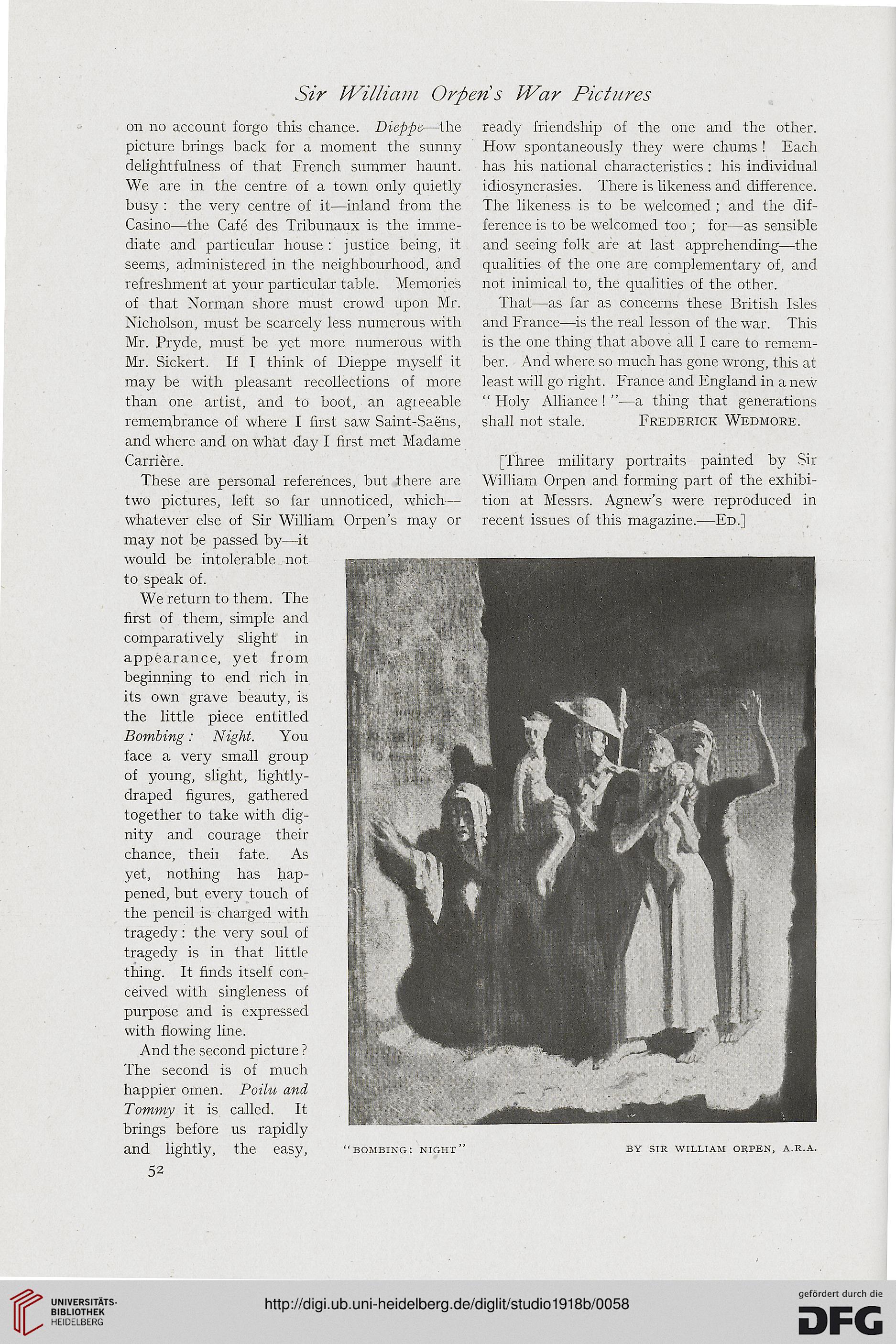Sir William Or fieri's War Pictiires
on no account forgo this chance. Dieppe—the ready friendship of the one and the other,
picture brings back for a moment the sunny How spontaneously they were chums ! Each
delightfulness of that French summer haunt. has his national characteristics : his individual
We are in the centre of a town only quietly idiosyncrasies. There is likeness and difference,
busy : the very centre of it—inland from the The likeness is to be welcomed ; and the dif-
Casino—the Cafe des Tribunaux is the imme- fcrence is to be welcomed too ; for—as sensible
diate and particular house : justice being, it and seeing folk are at last apprehending—the
seems, administered in the neighbourhood, and qualities of the one are complementary of, and
refreshment at your particular table. Memories not inimical to, the qualities of the other,
of that Norman shore must crowd upon Mr. That—as far as concerns these British Isles
Nicholson, must be scarcely less numerous with and France—is the real lesson of the war. This
Mr. Pryde, must be yet more numerous with is the one thing that above all I care to remcm-
Mr. Sickert. If I think of Dieppe myself it ber. And where so much has gone wrong, this at
maybe with pleasant recollections of more least will go right. France and England in a new
than one artist, and to boot, an agreeable " Holy Alliance! "—a thing that generations
remembrance of where I first saw Saint-Saens, shall not stale. Frederick Wedmore.
and where and on what day I first met Madame
Carriere. [Three military portraits painted by Sir
These are personal references, but there are William Orpen and forming part of the exhibi-
two pictures, left so far unnoticed, which— tion at Messrs. Agnew's were reproduced in
whatever else of Sir William Orpen's may or recent issues of this magazine.—Ed.]
may not be passed by—it
would be intolerable not
to speak of.
We return to them. The
first of them, simple and
comparatively slight in
appearance, yet from
beginning to end rich in
its own grave beauty, is
the little piece entitled
Bombing: Night. You
face a very small group
of young, slight, lightly-
draped figures, gathered
together to take with dig-
nity and courage their
chance, theii fate. As
yet, nothing has hap-
pened, but every touch of
the pencil is charged with
tragedy : the very soul of
tragedy is in that little
thing. It finds itself con-
ceived with singleness of
purpose and is expressed
with flowing line.
And the second picture ?
The second is of much
happier omen. Poilu and
Tommy it is called. It
brings before us rapidly
and lightly, the easy, "bombing: night" by sir William orpen, a.r.a.
52
on no account forgo this chance. Dieppe—the ready friendship of the one and the other,
picture brings back for a moment the sunny How spontaneously they were chums ! Each
delightfulness of that French summer haunt. has his national characteristics : his individual
We are in the centre of a town only quietly idiosyncrasies. There is likeness and difference,
busy : the very centre of it—inland from the The likeness is to be welcomed ; and the dif-
Casino—the Cafe des Tribunaux is the imme- fcrence is to be welcomed too ; for—as sensible
diate and particular house : justice being, it and seeing folk are at last apprehending—the
seems, administered in the neighbourhood, and qualities of the one are complementary of, and
refreshment at your particular table. Memories not inimical to, the qualities of the other,
of that Norman shore must crowd upon Mr. That—as far as concerns these British Isles
Nicholson, must be scarcely less numerous with and France—is the real lesson of the war. This
Mr. Pryde, must be yet more numerous with is the one thing that above all I care to remcm-
Mr. Sickert. If I think of Dieppe myself it ber. And where so much has gone wrong, this at
maybe with pleasant recollections of more least will go right. France and England in a new
than one artist, and to boot, an agreeable " Holy Alliance! "—a thing that generations
remembrance of where I first saw Saint-Saens, shall not stale. Frederick Wedmore.
and where and on what day I first met Madame
Carriere. [Three military portraits painted by Sir
These are personal references, but there are William Orpen and forming part of the exhibi-
two pictures, left so far unnoticed, which— tion at Messrs. Agnew's were reproduced in
whatever else of Sir William Orpen's may or recent issues of this magazine.—Ed.]
may not be passed by—it
would be intolerable not
to speak of.
We return to them. The
first of them, simple and
comparatively slight in
appearance, yet from
beginning to end rich in
its own grave beauty, is
the little piece entitled
Bombing: Night. You
face a very small group
of young, slight, lightly-
draped figures, gathered
together to take with dig-
nity and courage their
chance, theii fate. As
yet, nothing has hap-
pened, but every touch of
the pencil is charged with
tragedy : the very soul of
tragedy is in that little
thing. It finds itself con-
ceived with singleness of
purpose and is expressed
with flowing line.
And the second picture ?
The second is of much
happier omen. Poilu and
Tommy it is called. It
brings before us rapidly
and lightly, the easy, "bombing: night" by sir William orpen, a.r.a.
52




